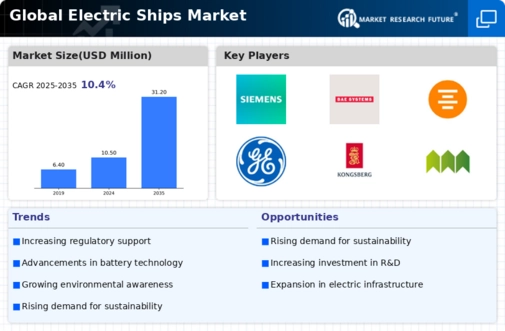Market Analysis
In-depth Analysis of Electric Ships Market Industry Landscape
A revolution is sweeping across the electric ship market as the marine sector adopts environmentally friendly ways to lessen its impact on the environment. A number of variables combine to drive the marketplace within the electric ship industry, with the global transition to cleaner energy sources being the main driver. The marine sector's push for decarbonization has increased funding and interest in electric ship propulsion technologies.
Two primary variables impacting the industry dynamics are the need to comply with stringent emission regulations and the growing consciousness of environmental concerns. Owners of ships and operators are looking for alternative propulsion technologies that can drastically cut greenhouse gas emissions as administrations and international organizations place higher emission limits on the maritime industry. Batteries- or hybrid-powered electric ships are a practical way to satisfy these regulations and support a more environmentally friendly marine sector. Innovations in technology also have a significant impact on the structure of the electric ships market. Electric propulsion systems, power retention systems, and battery technology are always evolving, which has improved the viability and efficiency of electric ships. Shipowners seeking to implement greener technology will find electric vessels increasingly appealing as their range and power grow along with the efficiency and power density of batteries. As a result, the dynamics of the market are strongly correlated with the rate of technical development, with businesses vying for market share by introducing the newest developments into their lineup of electric ships.
The market dynamics for electric ships are further shaped by government regulations and incentives. A number of nations are putting in place monetary incentives, grants, and laws that promote the use of electrical and hybrids power in the maritime industry. In addition to lowering the upfront costs of electric ships, these incentives also foster an atmosphere that encourages industry participants to spend money on R&D. The rate at which electric ships are adopted and the expansion of the market are both strongly influenced by government policies that are aligned with economic and environmental aims. The dynamics of the industry are also heavily influenced by its economic component. Electric propulsion solutions may need a larger initial investment than conventional alternatives, but the market is made more appealing by the possibility for better efficiency and long-term cost reductions. The financial advantages of electric ships, such as decreased fuel usage, fewer maintenance costs, and improved overall operating performance, are being recognized by shipowners more and more. The increasing business argument for electric ships is driving market dynamics as economic concerns converge with environmental aspirations.
Moreover, the competitive environment in the market for electric ships is changing quickly. Electrical and hybrid ship technologies are being actively developed and commercialized by both new and established maritime businesses. Competition shapes market dynamics, forcing businesses to set themselves apart through innovation, affordability, and the capacity to satisfy a wide range of client needs. Shipbuilders, technology suppliers, and energy storage businesses are increasingly forming partnerships and working together, which suggests that the challenges of developing electric ships are best approached together. In summary, government regulations, technology developments, environmental demands, economic factors, and an innovative competitive environment are all driving substantial changes in the electric ships market. With the potential to completely change how ships are powered and run on a global basis, the circumstances of the electrical ships industry are set for continuing growth as the shipping sector embraces sustainability in increasing numbers.
















Leave a Comment